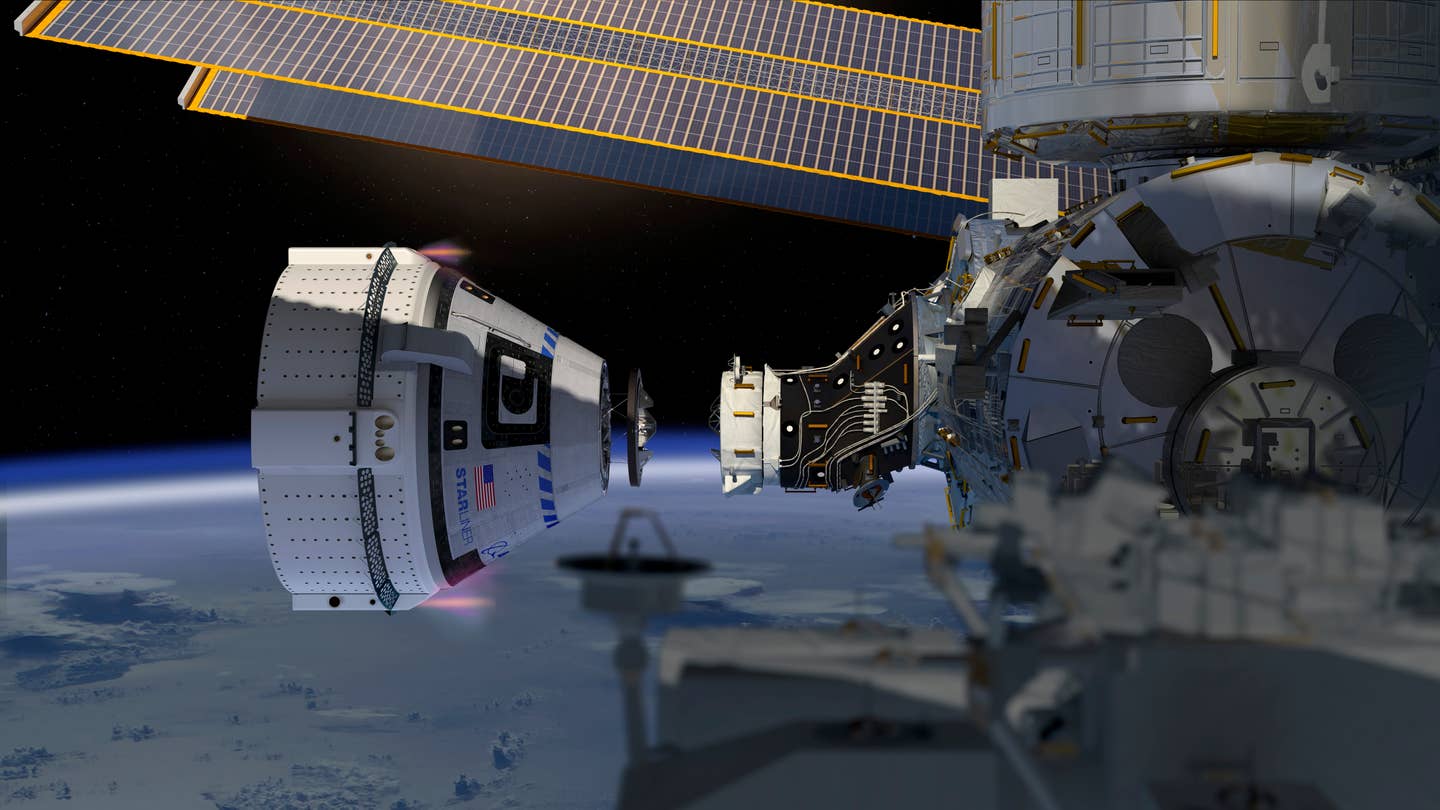NASA, Boeing Forgo Starliner Crewed Flight Test Until June Earliest
The postponement marks the fifth delay to the long-awaited mission, which would be the first time humans have flown on Starliner.

Boeing’s Starliner capsule successfully docks with the International Space Station during its second uncrewed flight test in May 2022. [Courtesy: Boeing]
Boeing’s Starliner, a semireusable vessel to the International Space Station (ISS) that has contended with a decade of delays to its inaugural Crewed Flight Test (CFT), will now launch no earlier than June
After postponing the previously announced May 25 launch attempt of the Starliner CFT on Tuesday, NASA on Wednesday said that it, Boeing, and launch provider United Launch Alliance, a joint venture between Boeing and Lockheed Martin, are targeting no earlier than Saturday, June 1, at 12:25 p.m. EDT for the next attempt. Additional launch windows include Sunday, June 2, Wednesday, June 5, and Thursday, June 6.
The postponement is the latest in a string of delays that have impacted the mission—and plagued the Starliner program more broadly—for years. An initial launch attempt was scrubbed hours before takeoff on May 6.
The setback follows the discovery of what NASA and Boeing described as a small helium leak on Starliner’s service module, which is designed to power and maneuver the autonomous spacecraft on its journey to the ISS.
According to NASA, Starliner teams have been meeting extensively to identify a new launch date, but further work remains. The agency said the current leak remains stable but that crews are now conducting follow-on performance and propulsion system assessments “to understand potential helium system impacts on some Starliner return scenarios.”
NASA will also perform a Flight Test Readiness Review to recap the work that has been done since May 6 and explain the rationale for attempting the next launch. A date for that review has not been identified but will be announced once selected, it said.
“It has been important that we take our time to understand all the complexities of each issue, including the redundant capabilities of the Starliner propulsion system and any implications to our Interim Human Rating Certification,” said Steve Stich, manager of NASA’s Commercial Crew program. “We will launch [astronauts] Butch [Wilmore] and Suni [Williams] on this test mission after the entire community has reviewed the teams’ progress and flight rationale at the upcoming Delta Agency Flight Test Readiness Review.”
NASA views Starliner as an alternative to SpaceX’s Crew Dragon for missions to low-Earth orbit. Dragon has flown each of the space agency’s eight Commercial Crew rotation missions, ferrying astronauts to and from the ISS, and will facilitate the upcoming Crew-9 mission scheduled for August.
But NASA wants to keep two reusable spacecraft in its fleet in case of a contingency, such as the incident that stranded astronaut Frank Rubio on the orbital laboratory for six months.
Boeing and SpaceX in 2014 each signed multibillion-dollar contracts with the agency to secure test flights and several Commercial Crew missions for their respective vessels. SpaceX has since expanded its arrangement multiple times, while Starliner—which is under contract for six flights—has languished in the development phase.
The Starliner CFT is intended to be the spacecraft’s final test flight before NASA certifies it for Commercial Crew rotation flights. If all goes according to plan, the spacecraft’s first commercial mission to the ISS, Starliner-1, could take place next year. But the delays continue to pile up.
The mission was initially scrubbed due to an oscillating pressure regulation valve on ULA’s Atlas V rocket, which will send Starliner into orbit. The partners set a new target launch date of May 10, later revising it to May 17 to give crews additional time to resolve the issue.
Then, last week, teams discovered a new problem—this time involving a helium leak on one of the Starliner capsule’s 28 reaction control system thrusters. Helium allows the thrusters to fire and make minor maneuvers in orbit. As a result, the launch was pushed to no earlier than Tuesday, a timeline that was then revised yet again to Saturday.
With Wednesday’s announcement, the partners are now nearly one month behind schedule, placing the Starliner team in a bind. On one hand, the safety of the astronauts must be prioritized. But on the other, there is some pressure to launch sooner rather than later.
As Ars Technica’s Stephen Clark notes, the ISS docking schedule gets a bit crowded after July, so there is some pressure for Starliner teams to launch sooner rather than later. In addition, Space Launch Complex 41 at Cape Canaveral Space Force Station in Florida—from where Starliner will launch—is used by ULA for other Atlas V and Vulcan Centaur launches.
Like this story? We think you'll also like the Future of FLYING newsletter sent every Thursday afternoon. Sign up now.

Subscribe to Our Newsletter
Get the latest FLYING stories delivered directly to your inbox






